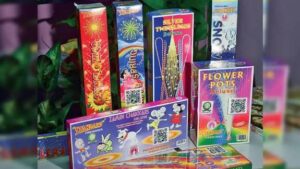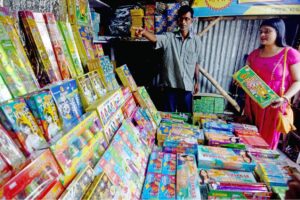Digital News Guru New Delhi Desk:
Green fire-crackers go on sale in Delhi: a cautious step amid pollution concerns
As the festival of lights approaches, the city of New Delhi has taken a carefully-calibrated leap into allowing the sale of so-called “green crackers”. Starting 18–20 October 2025, only fire-crackers certified as “green” by the CSIR‑National Environmental Engineering Research Institute (NEERI) or the Petroleum & Explosives Safety Organisation (PESO) may be sold in the capital, bearing valid QR-codes and through licensed dealers.

What’s allowed – and what’s not
According to the terms laid out by the Supreme Court of India and enforced by the Delhi Government and police, the key conditions are:
- Sale is restricted to certified “green” fire-crackers (traditional crackers remain banned).
- Sale window: October 18 to 20. Use (bursting) permitted only during restricted time slots on the day before Diwali and Diwali itself (typically 6:00–7:00 a.m. and 8:00–10:00 p.m.).
- Only licensed dealers can sell the article-approved crackers at specified, designated locations.
- The packaging must carry the green-fireworks logo and a QR code that can be scanned to verify both manufacturer and certification details.
- Enforcement teams are in place to monitor compliance, check QR codes, inspect stock, and take action against unauthorised sales.
Why the “green” route?
Delhi has, for years, grappled with dangerous spike in air-pollution following Diwali. Standard fire-crackers, with heavy use of barium, sulphur, aluminium and other metals, contribute significantly to particulate matter and toxic emissions. The “green crackers” are engineered to relieve some of that burden: NEERI’s research indicates a reduction of about 30% in particulate matter (PM) and measurable reductions in sulphur dioxide and nitrogen oxides compared to conventional crackers.
In its order, the Supreme Court acknowledged the need to strike a balance between cultural festivity, industry livelihood and the right to clean air — stating that a blanket ban simply drives illicit trade and deeper pollution.

Prospects and pitfalls
Pros:
- By permitting only certified green crackers, the regulatory authorities are attempting to align festive celebration with environmental responsibility.
- The limited sale window reduces the exposure period and concentrates monitoring efforts.
- The QR code system and licencing introduce traceability which was largely absent earlier.
- Industry-transition (manufacturers shifting to green formulations) offers hope for long-term structural change.
Pitfalls:
- A 30% reduction in particulate emissions still means arguably significant pollution; “less harmful” is not “harmless”.
- Enforcement on the ground is weak and uneven: many unlicensed stalls are already selling cracked/unverified fireworks, the “green” label is sometimes a façade.
- Supply-chain and licensing issues may hamper authorised sale: some districts had zero applications for temporary licences even as time ticks.
- Consumer awareness is limited: many buyers cannot distinguish genuine green crackers, nor do all vendors know of the QR code requirement.
- Culture and demand: fireworks are deeply embedded in Diwali celebrations; diverting behaviour overnight is hard.
What to look out for this festival season
- When buying, check for the green-fireworks logo and valid QR code on the pack; you can scan it via NEERI’s mobile app or portal to verify maker and certification.
- Ensure the retailer is licensed and the product is sold at a designated, approved location within the October 18–20 window.
- Burst fireworks only within the permitted hours (6-7 a.m. & 8-10 p.m.) and only on the days approved.
- Be vigilant: if the box looks like a conventional cracker but claims “eco-friendly”, check for the QR code and certification; fake labels are rampant.
- Encourage moderation: even green crackers add to smoke and dust, so limiting use helps air quality and health.
- If you spot unlicenced sales or misuse, you can report to the Delhi Police helpline (112) or DPCC.

Why this matters beyond festivals
The move to certified green fire-crackers is more than a Diwali regulatory tweak — it reflects growing recognition that cultural practices, commerce and environmental health must coexist in rapidly urbanising India. Delhi’s air-quality crisis during winter has repeatedly highlighted how festivals and consumer behaviours can exacerbate pollution. By imposing a short window, traceability, licencing and reduced-emission products, the policy may serve as a test-case for other Indian cities.
For the fire-works industry too — which supports thousands of workers across manufacturing clusters — the shift presents both challenge and opportunity: conventional high-boom, high-smoke crackers may be increasingly disfavoured, pushing manufacturers to innovate and adopt cleaner chemistry.
Finally, for citizens, the experiment offers a chance at celebrating with sparkle and a conscience: choosing less-harmful options, reducing noise and air impact, and building awareness about how tradition can evolve for contemporary concerns of public health and environment.
As Delhi braces for Diwali, the green cracker regime is set to face its first big test. Whether the QR-code, licencing and restricted-use model can genuinely curtail pollution while preserving festivity remains to be seen — the coming days will tell whether sparkle comes with responsibility.
You May Also Read: NITI Aayog’s ‘We Rise’ Initiative Selects 100 Women-Led MSMEs for Export Growth








